 You can go up if you guess what number I'm thinking. Hint: it has a dollar sign before it and two zeros after. 
Above: more nice work from illustrator James Meese, this time for David Loughlin's novel A Private Stair. It originally appeared in hardcover in 1950, with this Signet paperback edition coming in 1956.
 Fear and loathing are the least of his problems. 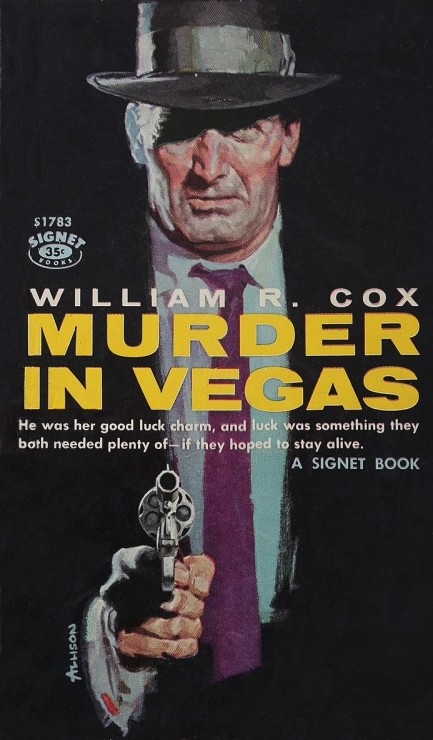
Jerry Allison art strikes a menacing note on the cover of William R. Cox's 1960 novel Murder in Vegas, in which Cox's gambler hero Tom Kincaid from 1958's Hell To Pay, which we recently discussed, returns to the written page to find more trouble. The first murder in the book actually occurs in Los Angeles, but someone is later knocked off in Vegas and as a direct result Kincaid is elevated from silent partner to full owner of a casino called the White Elephant. Simultaneously his girlfriend Jean Harper is in town filming a movie, and the murder and film production seem tied together. Kincaid is as interesting as before, but the fun creation here is down-on-her-luck party girl Carry Cain, who mixes sexiness and vulnerability with a beatnik mentality. She's an aspiring actress and gambling addict who thinks Kincaid might finally bring her the luck she's been seeking. Instead she finds herself in the middle of a Vegas-sized mess. Cox has talent, as we've noted before. It shines bright in Murder in Vegas.
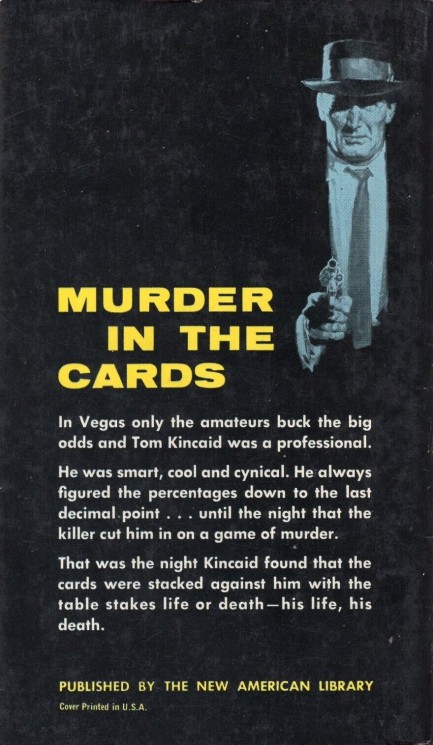
 This ain't Happy Days and he ain't the Fonz. 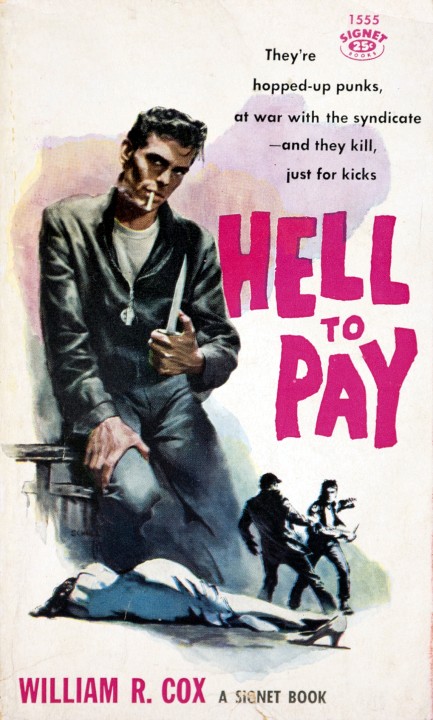
Since reading William R. Cox's 1961 thriller Death Comes Early we'd been looking around for more from him and located 1958's Hell To Pay, which you see above with a Robert Schulz cover. Cox writes in that same cool style we noted before, as he combines two crime sub-genres—organized crime, and juvenile delinquency. His main character Tom Kincaid is a successful NYC gambler who gets swept up in a mafia takeover centered around crooked boxing. Kincaid is thought by a kingpin named Mosski to be working for an upstart mob, which essentially makes this a find-the-real-killer novel in the sense that if Kincaid can't prove he isn't setting up Mosski his ass is grass. The book has in abundance generation gap musings, shady mingling between criminals and cops, poker described in hand-by-hand detail, and a lot of shooting and/or brutal beatings. Cox provides several good secondary characters, particularly Kincaid's been-around-the-block girlfriend Jean Harper. She's flawed, but then so is everyone here. There's a sequel to Hell To Pay, and we're onto that already. 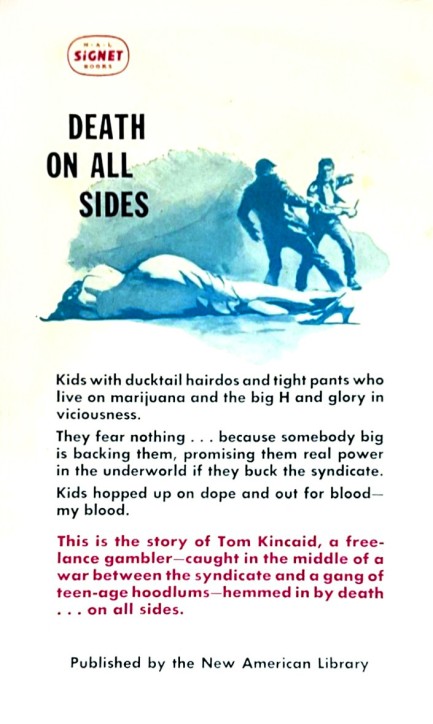
 I'd have sex for free, but that would be irresponsible from a business perspective. 
The 1962 Signet paperback of The Hundred-Dollar Girl has striking cover art by Jerry Allison, whose nice work we've seen before here, here, and here. William Campbell Gault's tale sees L.A. private dick Joe Puma investigating whether a boxing match was fixed, then finding himself in the middle of murder and an organized crime takeover of the fight racket. This is the second Puma we've read, and as with the previous book, he gets laid a couple of times, gets ko'd a couple of times, and beats up a couple of guys. All this is fine, but we haven't yet read the Gault novel that makes us sit up and go, "Ahh!" Certainly though, he's been good enough to make looking for that special book a pursuit we expect to pay off. We'll keep looking. In the meantime, if you want an L.A. crime read, you can do worse than The Hundred-Dollar Girl.
 Only Coffin Ed and Gravedigger can put out a blaze this hot. 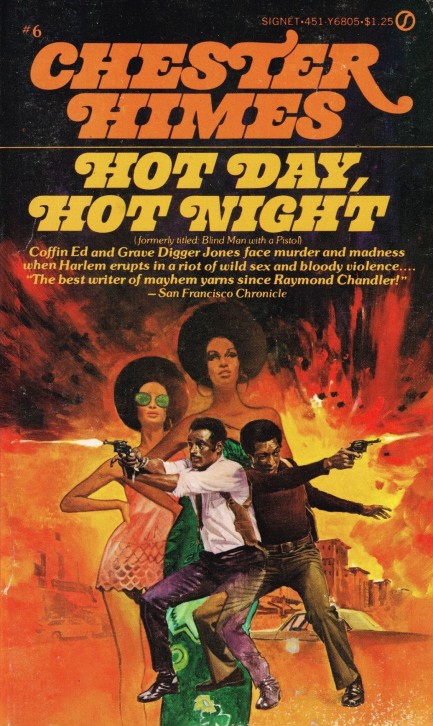
Above: an alternate cover for Hot Day Hot Night by Chester Himes, the 1975 edition from Signet Books. We talked about this thriller starring the fictional cop duo Coffin Ed Johnson and Gravedigger Jones in detail at this link. The art here is uncredited, as is this cover and this one by the same artist. Major demerits for Signet.
 Don't look at me that way, raspberry martini. You know as well as I do you've been responsible for all my problems. 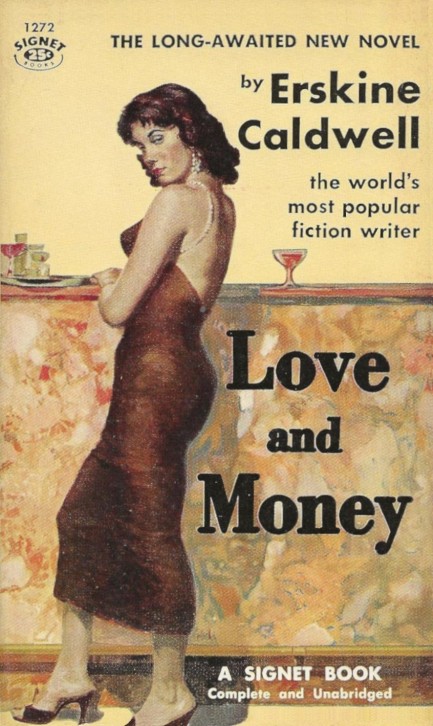
Do you have a friend like this? We bet lots of you do. The woman on Erskine Caldwell's Love and Money looks like she's playing hard to get, but her friend looks like the persuasive sort, so we bet she'll give in. This came from Signet Books in 1956 and the cover was painted by James Avanti. It fits into our ever growing women-in-bars collection.
 Louisiana territory proves extremely inhospitable in 1957 manhunt thriller. 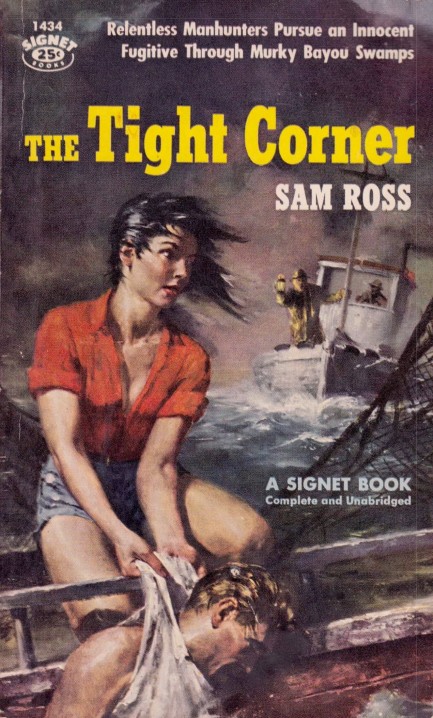
We bought The Tight Corner by Sam Ross because it was cheap. We knew nothing about Ross, and the uncredited cover art is decent but not special. But price sometimes wins, so we found ourselves reading a five dollar paperback about an ex-boxer named Tommy Berk who gets tangled up in a gambling scam gone wrong, is hunted by police for a murder he didn't commit, and after being shot and falling off a ferry in the Mississippi River Delta near New Orleans, is rescued by a Cajun fisherman and his sister as they take their shrimp boat out to sea.
Meanwhile, back on land, Berk's partners in the scam are looking for him to kill him. They're a diverse trio. Steve is a cold, calculating sociopath, but one with a secret weakness; Willy is an addle-brained killer, a trained attack dog; and Vi is a femme fatale who serves as the plot's honeytrap but is looking for a way to get out of the criminal life. It doesn't take long for them to realize Berk is somewhere at sea and has no choice but to come back sooner or later. When he does, they'll be waiting.
The Tight Corner is why we love buying vintage books. It's well written. Its bayou and ocean setting, simple but believable plot, and hard luck main character you end up liking all work in its favor. In addition, the prose has a lyrical style that's pleasing to read:
It was all mixed up in him and he saw himself swirling in her sea-green eyes. All at once, in the way she gazed at him, he seemed to plunge into them. He found himself close to her. And when he kissed her, he felt the sun she had been under all her life melt through him.
There are page-long passages written in that style and they're mostly interesting, though the book's dialogue suffers from name overusage. You know what we mean:
“It takes a lot of living to grow up, Jo.”
“Why'd he leave us, Adam?”
“Animals in a trap do strange things, Jo.”
“But I don't understand, Adam.”
People don't talk like that, so we generally take it as a sign of a bad ear for dialogue, but Ross does well with Cajun vernacular. He doesn't try to write their accents. Instead he uses careful word choices to lightly infuse their speech with the correct flavor. It works, and in the end, that and other positives outweigh the negatives, making The Tight Corner a saga that entertained us greatly. If you see it somewhere at a reasonable price, we think it's worth a read.
 It was an invitation she couldn't refuse. 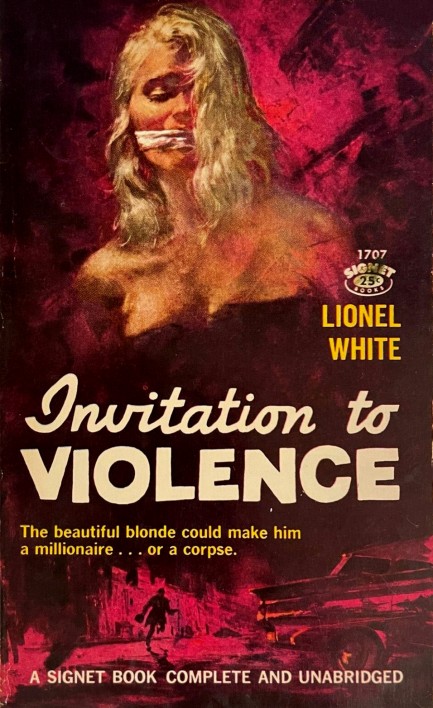
Our latest literary foray has been Lionel White's 1959 crime novel Invitation to Violence, but first let's acknowledge this brilliant cover. It's uncredited, but we love it—especially the lower quarter, with its sprinting gunman and finned classic car. The story hinges upon a car. Everyman Gerald Hanna drives by an early a.m. jewel heist in progress, but one in the midst of going haywire because two cops have stumbled upon it. There's a shootout in progress, men down, and one of robbers forces himself into Gerald's car to make a getaway. The robber has been shot in the head, and after a succesful escape from the scene of the crime keels over dead. Gerald dumps the body and—whaddaya know—is left with a bag of jewels worth $250,000. You could call this a case of right place right time, or wrong place wrong time. The first will be true if Gerald gets to sell the loot and ride away into the sunset, and the second will be true if he's in a Lionel White novel.
The jewels corrupt Gerald's ethics immediately and comprehensively. Instead of turning them in to the police he attempts to profit from them, and the difficulties he encounters are myriad, involving characters ranging from the sister of the dead thief, to the heist's silent backer, to two clever cops who think Gerald was one of the original thieves. Gerald is educated. He's an accountant by trade. He knows how to plan, think ahead, and weigh odds. But everybody is working against him, even his fiancée, who unwittingly throws a wrench into his scheme because she's angry at being stood up the night Gerald was just a little preoccupied by a mortally wounded jewel thief bleeding out in his Chevy. Right place right time, or wrong place wrong time? White writes happy endings sometimes, so it isn't actually a foregone conclusion how Gerald's story wraps up. But it's a foregone conclusion that it will be a crazy ride. 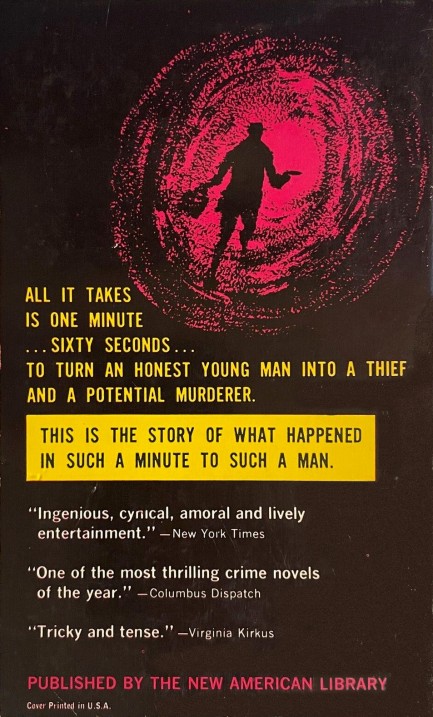
 They say vengeance is a dish best served cold. But hot works fine too. 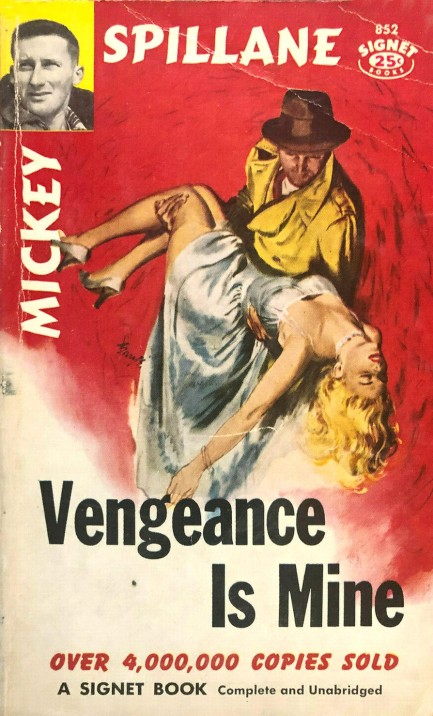
Vengeance Is Mine is Mickey Spillane's third Mike Hammer novel, and sees the violence addicted shamus lose his investigative license, then a close army buddy, then be haunted when a woman enters his life who resembles his fiancée Charlotte Manning, who he killed in his debut outing I, the Jury. This new woman is named Juno Reeves, and as Hammer attempts to avenge the murder of his friend, she provides an unnerving reminder of his past. She'll be even more unnerving in his future, but that's all we'll say about her. On the subject of revenge best served cold, forget it. Hammer wants white hot vengeance right now. The stark difference between Spillane's approach and that of other crime authors is that he writes Hammer as so mean the character is actually odious, but that's his game, and as a reader you go in accepting it. Sometimes, as in I, the Jury and Kiss Me Deadly, it's pulp gold. Vengeance Is Mine is more like silver, however it does have an incredible punchline ending you won't forget. The cover art here is by Barye Phillips, part of a set he painted for the series. You can see the others here. 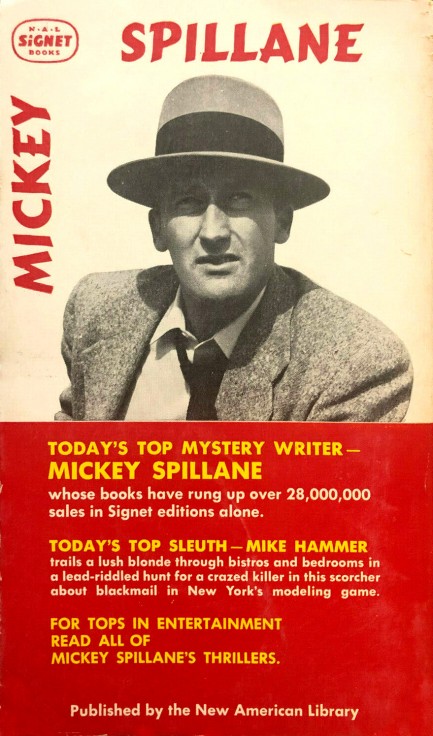
 You paid the cover charge to get in. Now you have to pay the uncover charge or get out. 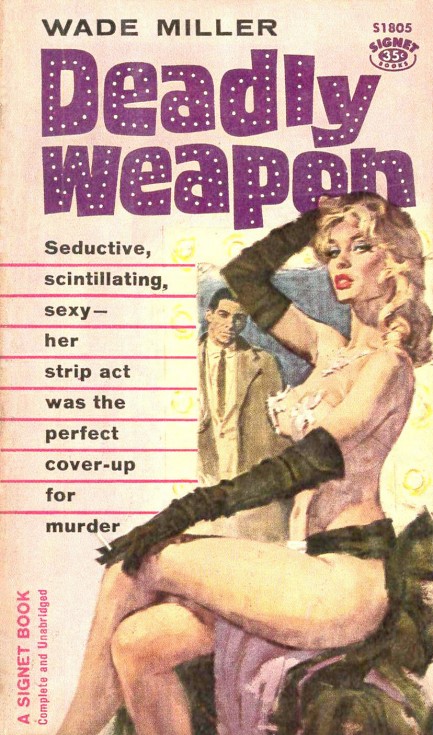
The brush behind this cover for Wade Miller's 1946 debut thriller Deadly Weapon was paperback vet Bob Abbett, and it's one of his better pieces in a portfolio filled with top efforts. The book is good too. It's about an Atlanta detective who drives to San Diego to avenge the death of his partner, and as befits such a concept, features excellent Sam Spade-like repartee between main character Walter James and a local cop named Austin Clapp. Some of the action is centered around a burlesque theatre and its headlining peeler Shasta Lynn, but the deadly weapon isn't a femme fatale, as implied by the art, but Walter James himself. The man is hell on wheels. He even uses his car to ram another auto and its occupants over a cliff. Overall, Deadly Weapon is well written, well paced, and well characterized (if a bit saccharine in the romantic subplot). Wade Miller—who was really Bob Wade and Bill Miller acting as one—started his/their career on a good note with this one.

|
 |

The headlines that mattered yesteryear.
2003—Hope Dies
Film legend Bob Hope dies of pneumonia two months after celebrating his 100th birthday. 1945—Churchill Given the Sack
In spite of admiring Winston Churchill as a great wartime leader, Britons elect
Clement Attlee the nation's new prime minister in a sweeping victory for the Labour Party over the Conservatives. 1952—Evita Peron Dies
Eva Duarte de Peron, aka Evita, wife of the president of the Argentine Republic, dies from cancer at age 33. Evita had brought the working classes into a position of political power never witnessed before, but was hated by the nation's powerful military class. She is lain to rest in Milan, Italy in a secret grave under a nun's name, but is eventually returned to Argentina for reburial beside her husband in 1974. 1943—Mussolini Calls It Quits
Italian dictator Benito Mussolini steps down as head of the armed forces and the government. It soon becomes clear that Il Duce did not relinquish power voluntarily, but was forced to resign after former Fascist colleagues turned against him. He is later installed by Germany as leader of the Italian Social Republic in the north of the country, but is killed by partisans in 1945.
|

|
|

It's easy. We have an uploader that makes it a snap. Use it to submit your art, text, header, and subhead. Your post can be funny, serious, or anything in between, as long as it's vintage pulp. You'll get a byline and experience the fleeting pride of free authorship. We'll edit your post for typos, but the rest is up to you. Click here to give us your best shot.

|
|





























































































